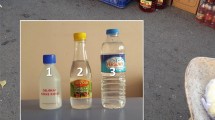Abstract
We evaluated the outcome and optimal management of corrosive esophagitis in 24 children (male:female=8:16, mean age 5.0±5.4 years old, ranged from 15 months to 18 years of age) from January 1984 to July 2001. In 20 patients this was the result of accidental ingestion, 4 were suicide attempts and 15 patients (63%) were below 3 years of age. The ingested substances included alkali (n=17, 71%), acid (n=6, 25%), and neutral detergent (n=1, 4%). The “dumpling alkaline oil”, a traditional food additive used in Taiwan, was the most common culprit in this study. A total of 9 patients ingested the dumpling alkaline oils, which comprised 38% of the total 24 patients and 53% of the 17 alkaline ingestion accidents. Of the patients 21 (88%) suffered from esophageal injury, and 15 among these 21 patients developed esophageal strictures. Esophageal strictures occurred in all patients with second or third-degree burns. Of these 15 patients with esophageal strictures, 9 (60%) received endoscope-associated dilatation and 6 (40%) underwent an operation (esophagectomy and intestinal interposition). The 9 patients who did not develop esophageal strictures had good body weight gain without feeding difficulty (functionally normal recovery). On the other hand, among the 15 patients with esophageal strictures, 9 patients had functionally subnormal recovery and 6 patients had poor recovery with either frequent feeding difficulty or growth retardation. In conclusion, accidental ingestion of alkaline oil is the most common cause of corrosive esophagitis in Taiwan. The degree of burns correlated with stricture formation.

Similar content being viewed by others
References
Marshall F (1979) Caustic burns of the esophagus: ten-year results of aggressive care. South Med J 74:590–594
Crain EF, Gershel JC, Mezey AP (1984) Caustic ingestion: symptoms as predictors of esophageal injury. Am J Dis Child 138:863–865
Leape LL, Ashcraft KW, Scarpelli DG, Holder TM (1971) Hazard to health—liquid lye. N Engl J Med 284:578–581
Wasserman RL, Ginsburg CM (1985) Caustic substance injuries. J. Pediatr 107:169–174
Spitz L, Lakhoo K (1993) Caustic ingestion. Arch Dis Child 68:157–158
Holler JA, Andrews HG, White JJ et al. (1971) Pathophysiology and management of acute corrosive burns of the esophagus: results of treatment in 285 children. J Pediatr Surg 6:578–584
Bautista A, Estevez E, Varela R, Villanueva A, Tojo R, Cadranel S (1997) A retrospective analysis of ingestion of caustic substances by children. Ten-year statistics in Galicia. Eur J Pediatr 156:410–414
Christesen HBT (1994) Epidemiology and prevention of caustic ingestion in children. Acta Paediatr 83:212–215
Rothstei FC (1986) Caustic injuries to the esophagus in children. Pediatr Clin North Am 33:665–674
Oakes DD, Shick JP, Mark JBD (1982) Lye ingestion: clinical patterns and therapeutic implications. J Thorac Cardiovasc Surg 83:194–204
London RL, Trotman BW, Di Marino AJ et al. (1981) Dilatation of severe esophageal strictures by an inflatable catheter. Gastroenterology 80:173–175
Huang YC, Chen SJ, Hsu WM, Li YW, Ni YH (2001) Balloon dilation of double strictures after corrosive esophagitis. J Pediatr Gastroenterol Nutr 32:496–498
Ring WS, Varco RL, L’Heareux PR et al. (1982) Esophageal replacement with jejunum in children. An 18–33 year follow-up. J Thorac Cardiovasc Surg 83:918–927
Mitchell IM, Goh DW, Roberts KD (1989) Colon interposition in children. Br J Surg 76:681–686
Author information
Authors and Affiliations
Corresponding author
Rights and permissions
About this article
Cite this article
Huang, YC., Ni, YH., Lai, HS. et al. Corrosive esophagitis in children. Ped Surgery Int 20, 207–210 (2004). https://doi.org/10.1007/s00383-004-1153-3
Published:
Issue Date:
DOI: https://doi.org/10.1007/s00383-004-1153-3




